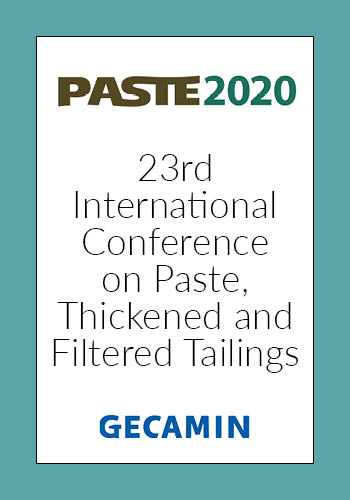Evaluation of the Effects of Climate Change on Water Infiltration on Thickened Tailings in the Atacama Region

|
Authors: Arriagada, A; García-Pérez, T; Riquelme, J |
DOI https://doi.org/10.36487/ACG_repo/2052_99
Cite As:
Arriagada, A, García-Pérez, T & Riquelme, J 2020, 'Evaluation of the Effects of Climate Change on Water Infiltration on Thickened Tailings in the Atacama Region', in H Quelopana (ed.), Paste 2020: 23rd International Conference on Paste, Thickened and Filtered Tailings, Gecamin Publications, Santiago, https://doi.org/10.36487/ACG_repo/2052_99
Abstract:
Chile is a country with high vulnerability associated with Climate Change, given among other factors, due to the need for development and growing social and environmental conflicts. This motivates the implementation of adaptation, transformation and mitigation measures at all aspects, to deal with climatological phenomena, which despite its future uncertainty, its development is a proven fact by robust and bulky scientific evidence. Motivated by the call from COP25 and the IPCC to assess adaptation and mitigation of effects and consequences of Climate Change, SRK Chile proposed to analyze the response of infrastructure associated with mining in northern Chile, considering General Circulation Models (GCM) downscaled for Atacama region at different elevations, based on the models considered by Chilean Water Directorate (DGA) in its Update of the National Water Balance of Chile (NWBC). This study considers Representative Concentration Pathways RCP 8.5 (most pessimistic scenario) as scenarios to evaluate, same as DGA – NWBC. To observe the effects of these scenarios we applied the GCM as boundary conditions in 1D numerical infiltration models using the software Hydrus. In the simulations water fluxes in a column of thickened tailing above natural soil is analyzed for different precipitation regimes from GCMs. Standard values according to our experience for the hydraulic and geometry properties of the materials forming the columns are used. The results of this study shed light upon the future precipitation’s scenarios affect the available water in the infrastructures at different elevations, providing a quantitative comparison of the infiltration fluxes within the tailing for the GCMs in the Atacama region.
References:
Coron L, Thirel G, Delaigue O, Perrin C, Andréassian V (2017). “The Suite of Lumped GR Hydrological Models in an R package.” Environmental Modelling and Software, 94, 166-171. doi: 10.1016/j.envsoft.2017.05.002.
CR2MET Database, Center for Climate and Resilience Research CR2, Universidad de Chile, Universidad de Concepción, Universidad Austral de Chile, CONICYT, URL:
DGA (2017), Actualización del Balance Hídrico Nacional, SIT N° 417, Ministerio de Obras Públicas, Dirección General de Aguas, División de Estudios y Planificación, Santiago, Chile, Realizado por: Universidad de Chile & Pontificia Universidad Católica de Chile, URL:
Rassam D., Simunek J., Mallants D., Van Genuchten M.T., (2018). The HYDRUS-1D Software Package for Simulating the One-Dimensional Movement of Water, Heat, and Multiple Solutes in Variably-Saturated Media: Tutorial.
R Core Team (2018). R: A language and environment for statistical computing. R Foundation for Statistical Computing, Vienna, Austria, URL:
Rojas M., P. Aldunce, L. Farías, H. González, P. Marquet, J. C. Muñoz, R. Palma-Behnke, A. Stehr y S. Vicuña (editores) (2019). Evidencia científica y cambio climático en Chile: Resumen para tomadores de decisiones. Santiago: Comité Científico COP25; Ministerio de Ciencia, Tecnología, Conocimiento e Innovación, URL:
© Copyright 2025, Australian Centre for Geomechanics (ACG), The University of Western Australia. All rights reserved.
View copyright/legal information
Please direct any queries or error reports to repository-acg@uwa.edu.au
View copyright/legal information
Please direct any queries or error reports to repository-acg@uwa.edu.au